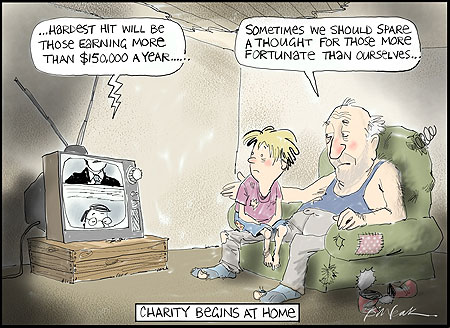Search
Democracy Links
Member's Off-site Blogs
the world of the milky bar kid .....
Kohler: The 2009 budget mirage
Business Spectator's Alan Kohler writes:
The Treasurer grandly describes it as the third phase of fiscal stimulus, and the headline number is an impressive $22 billion, as in (from Wayne Swan's speech): "The centrepiece of this Budget is the $22 billion we are investing in the infrastructure our nation needs to grow and prosper in the years ahead."
Actually, as discussed elsewhere, the centrepiece of the budget is a debt-funded increase in the old age pension.
As for infrastructure, I can only count $1 billion in the budget measures for next year, after which, according to the government's forecasts, the recession will be over and stimulus will no longer be needed.
Moreover, in describing the infrastructure investments, the budget papers frequently use the words "essential" and "urgent".
In other words, not only will these things take a long time, but they are not optional - they are needed not so much that our nation can grow and prosper, but simply so our nation can function.
The components of the $22 billion are listed in Budget Statement no.1, and each item represents the total investment required for each project by the time it is finished. There is $8.4 billion on roads, rail and ports, $3.5 billion on clean energy, $2.6 billion on education, $3.2 billion on hospitals and the old $4.7 billion investment the National Broadband Network. Total: $22.4 billion.
But don't look for those amounts in the actual budget expense measures. The clean energy initiative, for example, is in at a round number of $300 million a year; hospital infrastructure is in for $383 million next year and $273 million the year after; metro rail is down for $196 million next year and Network 1, the inland rail freight corridor, is down for just $75 million, after $742 million in the current year.
I managed to track down $53.2 million set aside for the National Broadband Network in 2009-10, for "implementation and establishment". The Department of Finance is also getting $1.1 million to set up the NBN company since its minister will be the shareholder.
How the rest of the projects were chosen is a little hard to fathom. The Infrastructure Australia report accompanying the budget papers is very glossy and printed on expensive paper, but the projects are not listed in order of recommended priority.
They are grouped under seven headings: NBN, national energy market, competitive gateways (ie ports), national freight network, transforming our cities, indigenous infrastructure and water.
The third, fourth and fifth of those categories (ports, freight and cities) contain eight to 10 projects each, listed in alphabetical order - a total of 29 projects. In the second half of the brochure, however, there are 38 projects listed across those three categories, also in alphabetical order.
This was done, presumably, to allow the government to pick the best projects for political purposes, rather than having to follow some set of externally recommended priorities, God forbid. This is politics, not economics, after all.
Of the 38 rail, road and port projects listed - alphabetically - by Infrastructure Australia, the government has picked 15, ranging in size from $20 million to $3.2 billion.
And the winner is...Melbourne! It gets $3.2 billion for the Regional Rail Express project, which is the proposed new rail link between West Werribee and South Kensington.
But then, Melbourne's rail project is chicken feed compared to Brisbane's and Sydney's, which are listed in the Infrastructure Australia document at $14 billion and $13.1 billion respectively. Far too expensive.
Wayne Swan's $22 billion includes $20 million for a feasibility study into the Brisbane project, but nothing for Sydney, although it gets $1.4 billion for the Hunter expressway, the second biggest on the list.
All of which is the "third phase of stimulus", and it should help us get out of the next recession, but not this one.
- By John Richardson at 12 May 2009 - 11:18pm
- John Richardson's blog
- Login or register to post comments

Recent comments
8 hours 17 min ago
8 hours 25 min ago
11 hours 56 min ago
13 hours 4 min ago
13 hours 16 min ago
13 hours 24 min ago
14 hours 47 min ago
15 hours 39 sec ago
17 hours 27 min ago
19 hours 8 min ago